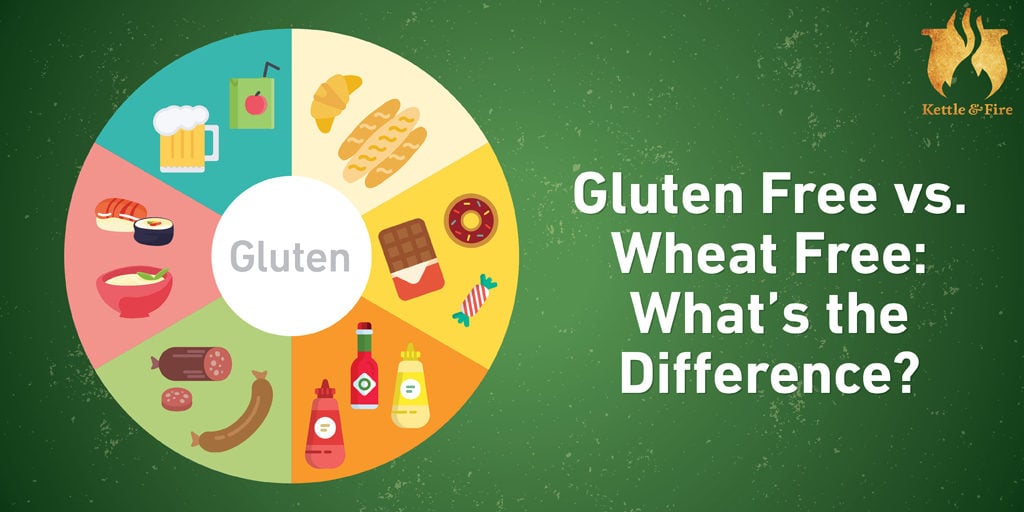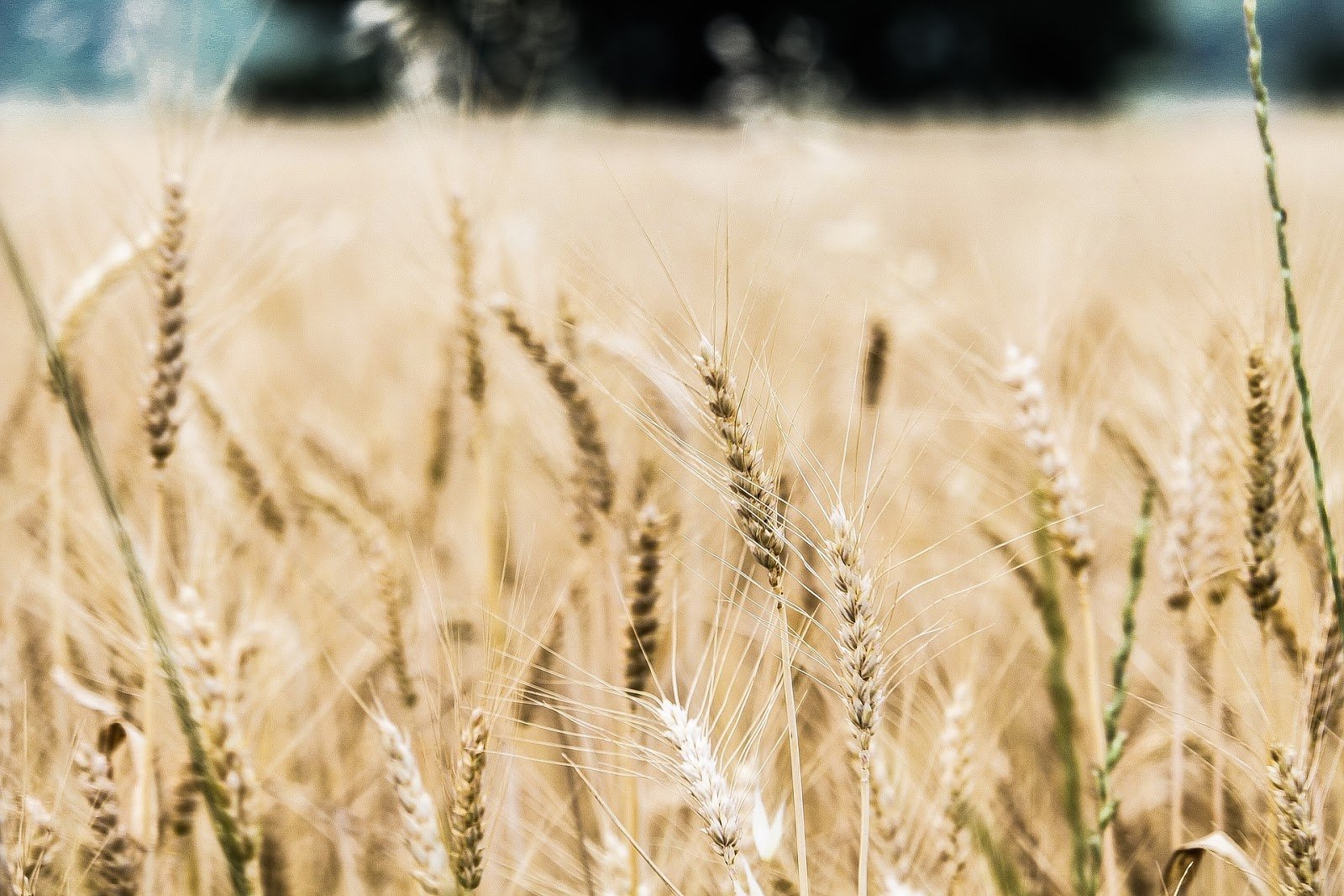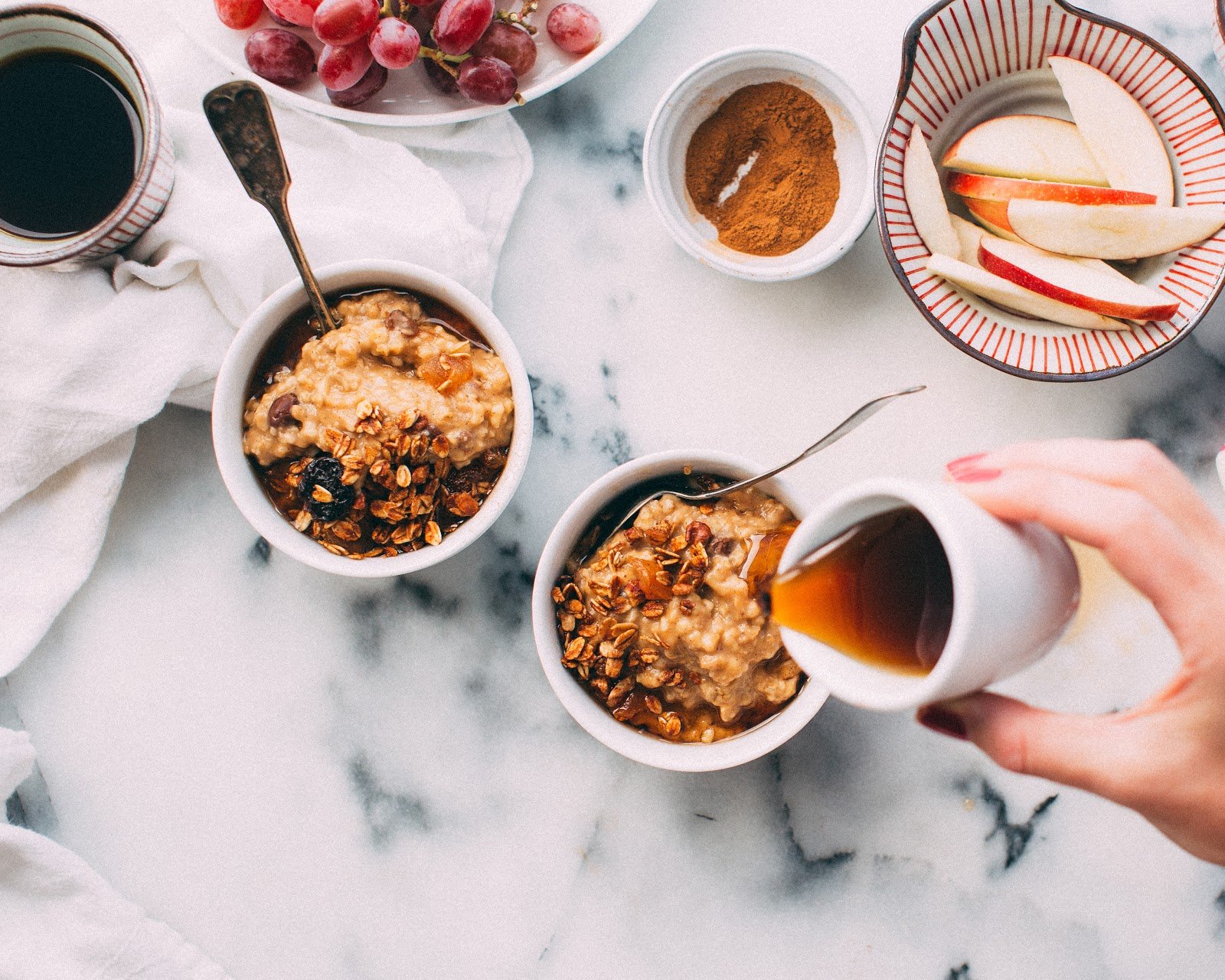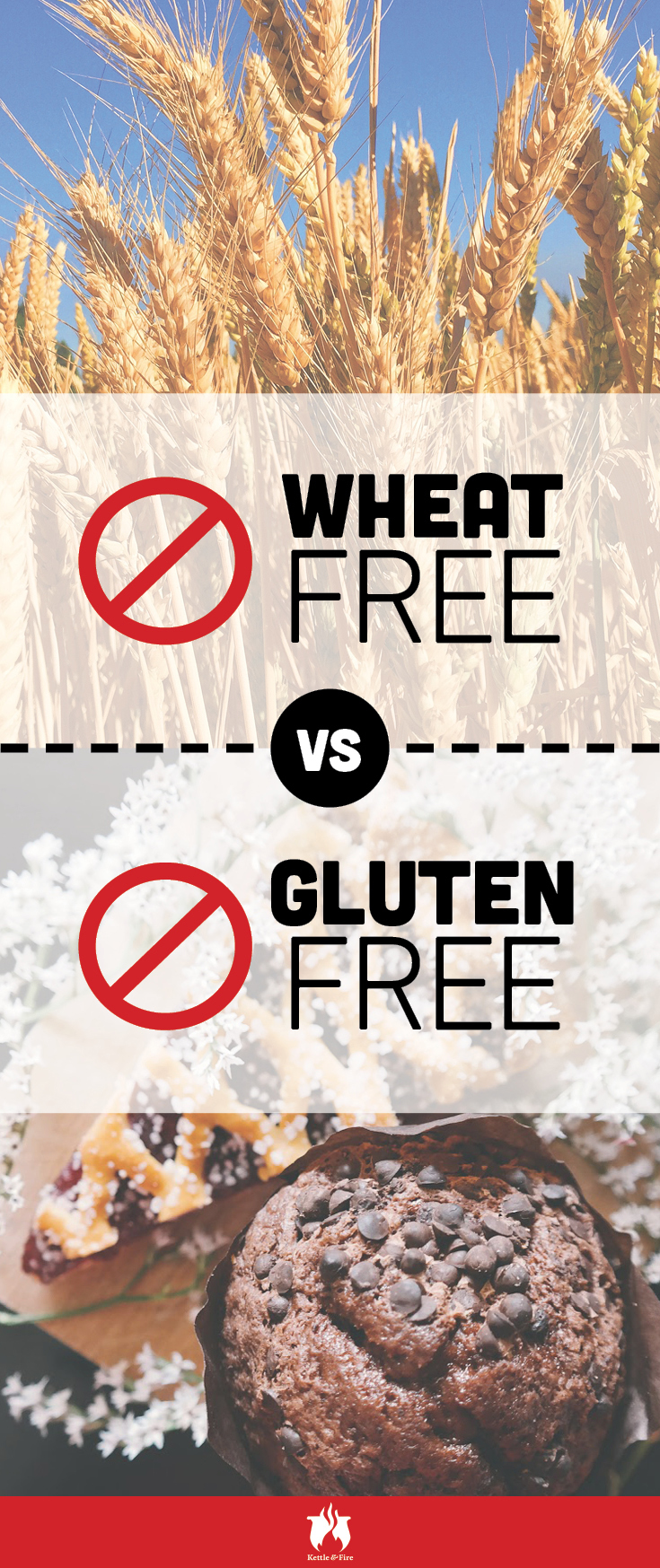Gluten-Free vs Wheat-Free: What’s The Difference?

The term “gluten-free” has shed its reputation as a diet trend and is now a household term thanks to the rising number of people with gluten sensitivities and celiac disease (1). However, gluten-free and wheat-free are often used interchangeably when they aren’t the same thing at all. Mixing up these terms not only creates confusion, but also has the potential to create serious problems for those who are sensitive to gluten.

What’s a Gluten-Free Diet?
Let’s clear up the main difference between wheat and gluten right away: gluten is a protein found in many grains, including wheat, while wheat is simply a grain that contains gluten. A gluten-free diet will be free from wheat and all grains and processed foods that contain gluten, but a wheat-free diet will not necessarily be free of gluten.
Gluten Sensitivity vs. Celiac Disease
A gluten sensitivity is different than a true gluten allergy, also known as celiac disease (2)(3).
If you’re sensitive to gluten you may experience symptoms similar to irritable bowel syndrome (IBS) such as brain fog, gas, diarrhea, and constipation as well as and skin conditions such as rashes when eating gluten-containing foods (4). Since food sensitivities often produce delayed reactions rather than sudden immune responses, signs of gluten sensitivity can take as long as 36 hours to show up.
It’s estimated that 18 million Americans have a non-celiac gluten sensitivity, which is close to the entire population of New York (5).
Unlike a food sensitivity, those with celiac disease will have a full-blown immune reaction when they come in contact with gluten. This can result in sudden cramping and diarrhea, several days of severe digestive symptoms, vomiting, fatigue, irritability and over time, extreme weight loss (6).
The Celiac Disease Foundation estimates that every 1 in 100 people have celiac disease, and most aren’t diagnosed.
Which Foods Contain Gluten?

Gluten is the “sticky protein” that gives bread, muffins, and pastries their ability to stretch and pull apart, which makes it easy to differentiate them from gluten-free grains. For example, a light, fluffy croissant will stretch apart when you break off a piece for your friend because gluten gives it the desirable stretchy properties.
On the other hand, a piece of gluten-free rice bread or a gluten-free pastry will be dense and crumble when you try to pull it apart (which is why you’ll rarely see a gluten-free croissant— although they do exist).
Aside from wheat, gluten is found in other grains such as kamut, spelt, barley, and rye. Oats are naturally gluten-free, but often become contaminated with gluten when they’re processed. This is why oats should always be assumed to contain gluten unless they’re certified gluten-free on the label.
The tricky thing about gluten is that it’s not just found in grains, but many processed foods, sauces, and condiments. This can make it difficult to avoid if you’re not sure where to look for it. Here are a few other foods gluten hides in:
- Beverages: brewer’s yeast (beer), some varieties of wine, apple juice (if it contains caramel coloring)
- Condiments: soy sauce, ketchup, tamari, nama shoyu, other sauces such as chipotle, mayo
- Restaurant Foods: sushi (artificial crab meat contains gluten), scrambled eggs (some restaurants “fluff up” their eggs with pancake batter, but eggs are otherwise naturally gluten-free
- Processed Meats: sausages, deli meats
- Meat Substitutes: veggie burgers, meat substitutes made with seitan (which is wheat gluten), some varieties of store-bought vegan cheese
- Store Bought Foods: pre-prepared soups (many use flour as a thickener), chocolate
- Sweeteners: Anything sweetened with malt syrup or brown rice syrup, which may contain barley enzymes (granola bars, candy, anything that contains “caramel color” as an additive, commonly found in coffee drinks and soda)
Gluten isn’t just limited to food sources either. Body care products and cosmetics contain gluten, which can be absorbed through your skin and produce the same reaction as if you’d eaten it.
Who Should Follow a Gluten-Free Diet?
Of course, anyone who’s been medically diagnosed with celiac disease should follow a gluten-free diet to avoid coming into contact with gluten. But what if you don’t have celiac disease? Should you still go gluten-free?
With the growing number of suspected gluten sensitivities, anyone who has gluten in their diet and experiences symptoms such as digestive discomfort, bowel irregularity, skin problems, brain fog, bloating, or fatigue, may benefit from a gluten-free diet, even if they don’t have a true gluten allergy. Anyone with leaky gut syndrome should also avoid gluten.
Leaky gut syndrome (also known as hyper intestinal permeability) is also a digestive condition that’s been shown to be caused and worsened by gluten (7). This is because gluten triggers the release of a protein called zonulin, which breaks apart the tight junctions in the digestive tract when overproduced (8). Over time, this exact mechanism is what allows small holes to form in the intestinal lining, causing it to become “leaky.”
Since leaky gut is now being recognized as an underlying cause of autoimmune conditions, inflammatory skin conditions, and digestive symptoms, removing gluten from your diet may not only improve your symptoms, but also prevent you from developing leaky gut down the road (9).
There are food intolerance tests (such as the IgG test) that can test for a gluten sensitivity, but these tests can’t always pick up on mild sensitivities that cause symptoms such as bloating or cramping. When it comes to determining if you’re sensitive to gluten, it can be one of those “body knows best” cases.
Step #1: Try completely eliminating gluten from your diet for at least 3 weeks, and closely tracking your energy levels, mood, digestion, and any other symptoms (such as skin breakouts or rashes) in a food and symptom journal (Notes in your smartphone works, too).
Step #2: Reintroduce gluten after a minimum of 3 weeks, and see if any symptoms appear or worsen (remember: a reaction to a food intolerance can take up to 36 hours). If you feel foggy, sluggish, or notice any changes in your digestion, you may have a mild gluten sensitivity and could also benefit from following a gluten-free diet.
What Can You Eat on a Gluten-Free Diet?

A gluten-free diet may sound restrictive, but it really just comes down to eating fewer processed foods and grains and focusing on whole foods like fruits, vegetables, healthy fats, and lean protein—which is the best way to support your overall health anyways.
- Gluten-Free Grains: brown rice, buckwheat, jasmine rice, quinoa, teff, amaranth, wild rice, and nut flour such as coconut and almond flour
- Condiments: coconut aminos (an excellent low sodium substitute for soy sauce), most varieties of regular mustard and Dijon mustard, most natural brands of ketchup are gluten-free
- Sweeteners: raw honey, pure maple syrup, green leaf stevia, coconut sugar, date sugar
Since gluten hides in most processed, boxed, and packaged foods, it’s easiest to follow a gluten-free diet when you prepare your meals at home where you can control exactly which condiments, sweeteners, and grains go into your meals (this is important for avoiding cross-contamination too, if you do have celiac disease).
And let’s not forget: gluten-free isn’t just a buzzword anymore. With the increasing sensitivities, many restaurants and grocery stores have gluten-free options available.
Note: Although many packaged and pre-prepared foods have a gluten-free label, keep in mind that gluten-free doesn’t always mean “healthy.” Most processed foods still contain high amounts of refined sugar, food additives, and preservatives.
What’s a Wheat-Free Diet?

As we covered above, a wheat-free diet isn’t a gluten-free diet— it’s a diet free from products containing wheat. Therefore, foods that contain gluten are still permitted as long as they’re wheat-free.
Some people are allergic or sensitive to wheat but can tolerate other gluten-containing foods just fine. This is more common in North America, where the wheat is processed differently. Most wheat available in the US today is called “dwarf wheat,” a hybridized version of wheat that was developed in the 1960s (10).
The problem with dwarf wheat, which may be linked to increasing wheat sensitivities and allergies, is that it’s higher in phytic acid, a protective coating found on grains that’s difficult for our bodies to digest (11).
Who Should Follow a Wheat-Free Diet?
Anyone with a wheat allergy should avoid products that contain wheat. For those who have a true wheat allergy, eating products that have even the smallest traces of wheat can trigger an IgE allergic reaction within minutes, which is accompanied by sneezing, itching, swelling, and in severe cases, anaphylaxis (12). Digestive symptoms can also occur and may last for days.
Just like gluten sensitivities, wheat sensitivities and true allergies can be tested using the igG food sensitivity tests, or the IgE allergy blood tests (13)(14).
If you don’t have a true wheat allergy but do experience digestive symptoms such as bloating or gas after eating wheat, you may also find relief from your symptoms by following a wheat-free diet. Similar to gluten, wheat sensitivities can also produce brain fog, bloating, bowel irregularity, and skin conditions like acne.
Since the most common version of wheat in the US is highly processed, sprayed with pesticides, and may be difficult for us to digest, it’s not exactly a healthy diet staple. In fact, we don’t know the long-term health effects of eating a hybridized version of wheat or ingesting the pesticides it’s sprayed with, which makes it a food to consider avoiding altogether, regardless of whether you have a wheat intolerance (15).
Which Grains are Wheat-Free?

Wheat-free grains include:
- Spelt
- Kamut
- Oats
- Barley
- Rye
- Millet
And of course, all of the gluten-free grains and flour alternatives listed above, such as quinoa and brown and wild rice.
You can also have a wider variety of condiments on a wheat-free diet compared to a gluten-free one— for example, wheat-free tamari is available, and most condiments (such as mustard or mayo) don’t contain wheat.
The bottom line: gluten is a protein found in many grains and processed foods, which can cause serious immune responses and allergic reactions in some people, and continues to be a growing food sensitivity. A wheat-free diet removes wheat, which is a common food allergy, but still includes other grains and foods that contain gluten.










